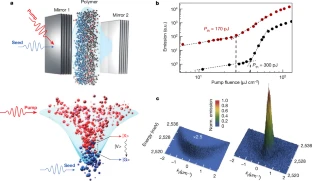Phys.org September 22, 2021
Based on light-matter coupling, an international team of researchers (Russia, Switzerland, Germany, UK) created an optical switch which in a proof-of-principle demonstration achieved switching with just one photon at room temperature. The switch could act as a component that links devices by shuttling data between them in the form of optical signals, and serve as an amplifier, boosting the intensity of an incoming laser beam by a factor of up to 23,000. The device relies on two lasers to set its state to “0” or “1” and to switch between them. The switching occurs inside a microcavity which keeps the incoming light trapped inside for as long as possible to favor its coupling with the cavity’s material. The exciton-polaritons created when photons couple strongly to bound electron-hole pairs are at the heart of the switch’s operation. They utilized stable excitons dressed with high-energy molecular vibrations, allowing for single-photon nonlinear operation at ambient conditions. The work opens new horizons for practical implementations like sub-picosecond switching, amplification and all-optical logic at the fundamental quantum limit…read more. TECHNICAL ARTICLE

The principle of the extreme nonlinearity in organics. Credit: Nature volume 597, pages493–497 (2021)